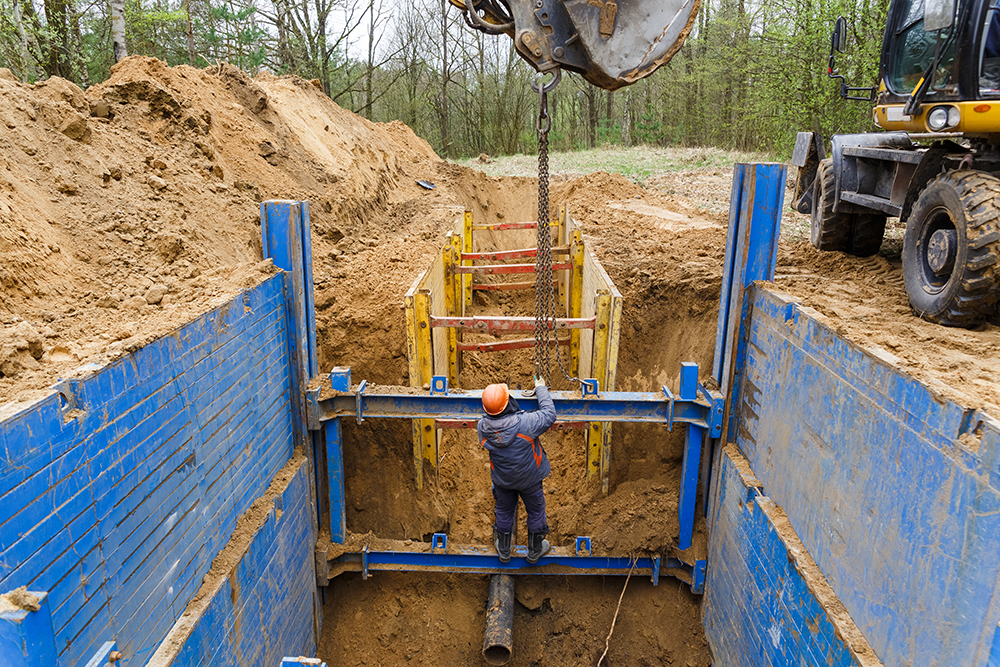
Excavation and Trenching Safety
By Jeremy J. Lancaster, CSP.
Excavation and trenching pose serious threats to worker safety. I personally experienced the long-lasting consequences of unsafe excavation and trenching practices when I lost my brother to a fatal excavation collapse. This article offers key lessons in safety and prevention to stop similar future fatalities.
Excavation and trenching are some of the most dangerous construction activities. About 35 fatalities occur each year in the United States on average, and about two-thirds of those fatalities occur in trenches that are less than 10 feet deep. In a recent 2022 event in Texas, two workers were killed when an unprotected trench more than 20 feet deep collapsed. Life-saving trench shields sat unused by the site (OSHA, 2022).
Furthermore, workers are at risk of death or serious injury if they enter an unprotected trench or excavation based on historical numbers across the United States (TEST, 2023).
• 2017: 24 fatalities
• 2018: 13 fatalities
• 2019: 21 fatalities
• 2020: 18 fatalities
• 2021: 15 fatalities
• 2022: 39 fatalities
• 2023: 8 fatalities (as of 8/7/23)


Educational resources are available through OSHA and ThinkInsideTheBox.Info to prevent trenching and excavation incidents.
In a more personal experience, I lost my brother to a trenching accident in 1987. The ramifications and impact of the accident have affected my family tremendously since that day. Protection and safety are paramount, and the consequences of not implementing safeguards, as I have witnessed firsthand, are long-lasting and scarring.
Protecting Trenches and Excavation Sites
Unprotected trenches and excavation sites pose serious risks to workers, including being buried by heavy soil. Dirt is especially heavy. One cubic yard can weigh the equivalent of a small vehicle (up to 3,000 lbs).
To address these dangers, OSHA requirements implemented to protect worker safety are covered by 29 CFR 1926.651 and 1926.652, which have been in place for many years. These standards apply to trenches 5 feet or deeper. To protect against shifting soil and trench cave-ins, shoring, sloping, and shielding are required.
• Slope or bench trench walls
• Shore walls with supports
• Shield trench walls with trench boxes
Key Safeguards
To properly safeguard workers, the following protections should be in place:
• Maintain a safe, clear entrance and exit
• Keep materials (spoil piles) away from the edge of the trench
• Note standing water or atmospheric hazards
• Properly inspect the trench before anyone enters
• Perform pre-job planning requirements, including identifying and protecting utility installations
• Emergency rescue equipment should be available at all times
• Perform daily inspections by competent person
• Instruct and train on safety regularly and before the work begins
• Avoid heavy equipment near the excavation site or digging under paved road
Applicable OSHA regulations must be thoroughly reviewed and understood before beginning an excavation. Please refer to the OSHA guidelines on trenching and excavation for more details (OSHA, 2015).
My Personal Experience:
Remembering Dwayne
In the loss of my brother in an excavation, many precautions were ignored leading up to the tragedy. My brother and I grew up in a small town in western Tennessee where everyone knew everyone. Our household was rooted in Christian faith, and we were a close-knit family. We remain so to this day. Dwayne loved ‘80s rock, his 4×4 Jeep, photography, the outdoors, and basketball. My friends and I looked up to him.
On the day of the incident, Dwayne and our family friend, Barry, were working on sewer lines as a summer job. The job was intensive manual labor and involved excavating old lines for replacement. The crew was small – about seven people. The excavation was located next to the road, approximately 10-12 feet deep. The walls of the excavation were straight down, close to 90 degrees. There were no protective systems in place. A water line was running across the top, which made it difficult to shore and shield the excavation. A heavy dump truck filled with debris and dirt was moved closer to the edge. Around that time, a section of the asphalt and dirt caved in, hitting the water main, and filling the excavation with water, asphalt, and dirt, covering Dwayne. He was 19 when he lost his life.
The funeral was standing room only, as a reflection of the great impact on so many lives. He is with our Lord now, and I will see him again one day.
What Went Wrong
The results of this tragic accident are still felt by those involved, including my family, Barry, and myself. What Dwayne experienced must be a lesson to prevent future tragic accidents.
First, the pre-job planning requirements for excavation projects must be met long before work begins. Based on what transpired, they were not.
The increased weight on the leading edge of the hole from heavy equipment (the dump truck) and the paved road added additional stress to the excavation. Protective measures and planning should have been put into place to avoid this additional weight. They were not.
Ladders for egress and trench boxes to prevent a cave-in were required. They were not used.
Inexperienced supervisors did not pay proper attention to safety, to identify hazards or soil classification. Excavation shoring was neglected because it would take extra time. An excavation competent person (CP) should have been present to supervise the safe operations. They were not trained and did not fulfill their role as competent personnel.
Safety equipment, including a harness, should have been available and used to protect workers. It was not.

Key Lessons for Trenching and Excavation Safety
I participated in a recent webinar where construction leaders are making a difference and changing the trends with excavation fatalities. The Trenching and Excavation Taskforce (TEST) is one and a great resource that makes a difference.
The Trenching Excavation Safety Taskforce brings more awareness to trenching and excavation safety and prevent injuries and fatalities. It works to create industry awareness and drive insight into trenching and excavation safety, collaborating without organizational or geographic boundaries to improve day-to-day safety for field workers (TEST, 2023). #ThinkInsideTheBox
Preventable trenching and excavation accidents still occur to this day due to the mistakes of convenience made for the sake of “saving time.” These mistakes are the same as the ones that contributed to Dwayne’s death. I hope others can learn from Dwayne’s experience. Please carry this message forward to prevent future harm to others and use what is available from groups such as OSHA, NIOSH, TEST, and other awareness groups to champion safety for others. YOU can make a difference, one trench and excavation at a time.
References
OSHA. (2022). Alarming rise in trench-related fatalities spurs US Department of Labor to announce enhanced nationwide enforcement, additional oversight | Occupational Safety and Health Administration (osha.gov)
29 CFR, Subpart P – Excavations, 1926.650-652. (n.d.). Code of Federal Regulations, Part 1926 – Safety and Health Regulations for Construction.
OSHA. (2015). OSHA 2226-10R “Trenching and Excavation Safety” website: osha2226.pdf
TEST. (2023). Retrieved from Trenching and Excavation Taskforce website: English (thinkinsidethebox.info)

25906 Nichols Sawmill Road · Magnolia, Texas 77355 · Phone: (281) 252.0005 Fax: (281) 252-0092 · www.jespear.com
Share This Article!

